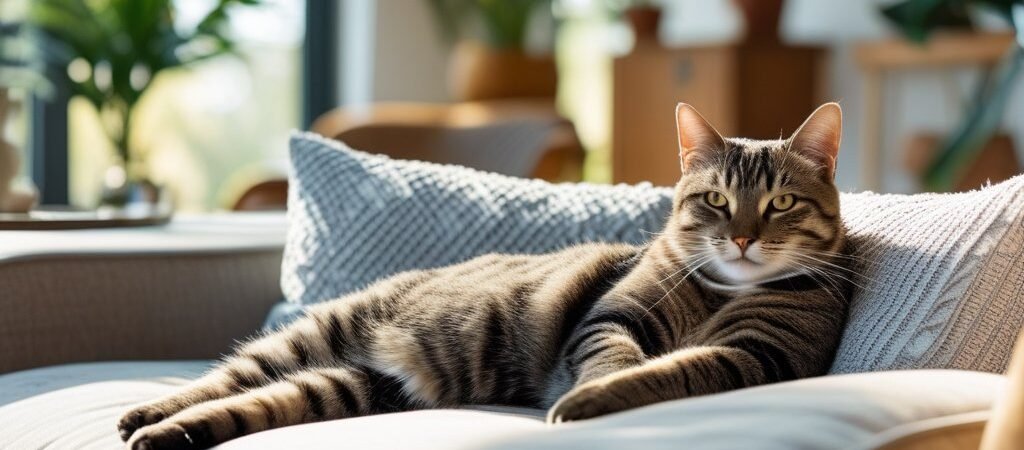A comfortable home environment makes a noticeable difference in a cat’s daily life. From safe spaces to climb and explore to quiet corners for rest, every detail shapes how a cat feels and behaves indoors. Creating the perfect cat-friendly home environment means balancing enrichment, safety, and comfort so a cat can thrive both physically and emotionally.

Cats naturally seek stimulation through play, scratching, and observation. Providing scratching posts, interactive toys, and elevated perches satisfies these instincts while protecting furniture and reducing stress. Simple adjustments, such as placing a perch near a window or setting up a secure outdoor enclosure, give cats opportunities to explore without risk.
Just as important as activity is relaxation. Cats need cozy resting spots where they feel secure, whether it’s a soft bed tucked away or a designated quiet area free from noise. By shaping the home with a cat’s needs in mind, owners create a space that supports health, happiness, and harmony for both pets and people.

A cat’s environment shapes its behavior, health, and overall comfort. Enrichment, safe introductions, and well-designed indoor spaces all play a role in helping cats feel secure and engaged in their homes.
How to Choose the Best Cat Toys for Enrichment
Cats benefit most from toys that stimulate their natural instincts—hunting, chasing, and problem-solving. Wand toys with feathers mimic prey movements, while small balls or mice encourage pouncing and batting.
Puzzle feeders add mental engagement by making cats work for food. These tools prevent boredom and reduce overeating, which is especially useful for indoor cats prone to weight gain.
When selecting toys, durability and safety matter. Avoid items with loose strings or small detachable parts that could be swallowed. Rotating toys weekly keeps them interesting and prevents cats from losing enthusiasm.
A simple way to organize toy choices is to think in categories:
| Toy Type | Benefit | Example |
|---|---|---|
| Interactive | Builds human-cat bond | Wand with feathers |
| Solo Play | Encourages independence | Catnip mouse |
| Mental Stimulation | Slows eating, reduces boredom | Puzzle feeder |
Variety ensures both physical exercise and mental stimulation, giving cats a well-rounded play routine.
Tips for Introducing a New Cat to Your Home
Bringing a new cat into a household requires patience and structure. A separate room with food, water, litter box, and hiding spots helps the cat adjust without feeling overwhelmed.
Scent swapping is an effective first step. Owners can exchange bedding or gently rub a cloth on each cat’s cheeks to introduce familiar smells before face-to-face meetings.
Short, supervised visits work better than forcing prolonged interactions. Using treats during introductions creates positive associations, reducing stress for both cats.
It’s important to monitor body language. Signs like flattened ears, growling, or hiding mean the cat needs more time before the next step. Progress often takes days or weeks, depending on each cat’s temperament.
Gradual introductions help prevent territorial conflicts and encourage long-term harmony in multi-cat homes.
Designing Safe Indoor Spaces for Cats
Indoor cats thrive when their environment offers both comfort and stimulation. Vertical spaces, such as cat trees and wall-mounted shelves, let cats climb and observe from above—an instinctive behavior that reduces stress.
Window perches provide entertainment by allowing cats to watch outdoor activity safely. Adding bird feeders outside a window can create a natural “cat TV.”
Scratching posts placed in different rooms protect furniture while meeting a cat’s need to mark territory and stretch muscles. Posts should be sturdy and tall enough for a full stretch.
Safety should always guide design choices. Keep cords, toxic plants, and small objects out of reach. Secure windows and balconies with screens to prevent accidents.
By combining climbing areas, resting spots, and safe exploration zones, cat lovers create an environment that supports both physical health and emotional well-being.

A cat-friendly environment balances safety, stimulation, and comfort. Attention to household layout, enrichment options, and indoor adjustments helps cats thrive while reducing stress and preventing unwanted behaviors.
Cat-Friendly Home
A cat-friendly home provides areas where cats can climb, scratch, and rest without interference. Vertical spaces such as shelves, cat trees, and window perches give them safe observation points.
Scratching posts placed in high-traffic areas prevent furniture damage while meeting natural scratching needs. Owners should provide multiple resting spots, including soft beds and enclosed hideaways.
Key features of a cat-friendly home:
- Vertical climbing structures
- Multiple scratching surfaces
- Quiet resting areas
- Access to windows or natural light
These elements create a balanced environment that supports both physical and emotional well-being.
Cat Safety
Safety measures protect cats from common household risks. Electrical cords should be covered or secured to prevent chewing. Toxic plants like lilies, philodendrons, and poinsettias must be removed or kept out of reach.
Windows should have secure screens to prevent accidental falls. Small objects such as rubber bands, hair ties, or string should be stored away, as ingestion can cause intestinal blockages.
Household hazards to monitor:
- Cleaning chemicals
- Sharp kitchen tools
- Open washing machines or dryers
- Human medications
By minimizing risks, owners create a secure environment where cats can explore without danger.
Cat Enrichment
Enrichment keeps cats mentally stimulated and physically active. Interactive toys such as feather wands, puzzle feeders, and laser pointers encourage exercise and play.
Rotating toys prevents boredom and maintains interest. Food-dispensing toys or treat puzzles slow down eating while promoting problem-solving skills.
Types of enrichment activities:
- Daily play sessions
- Interactive feeders
- Scent-based exploration with catnip or silvervine
- Training sessions using clickers and treats
Providing variety ensures cats remain engaged and reduces the likelihood of stress-related behaviors.
Cat Environment
The environment should support a cat’s natural instincts. Litter boxes must be placed in quiet, accessible areas, with one box per cat plus one extra recommended. Cleanliness is essential, as cats often avoid dirty boxes.
Temperature control also matters. Cats prefer warm, cozy areas, so beds near sunny windows or heated pads can improve comfort.
Environmental essentials:
- Clean litter boxes in suitable locations
- Warm resting areas
- Access to fresh water and food stations
- Consistent household routines
A stable environment reduces stress and helps cats feel secure in their territory.
Indoor Cats
Indoor cats rely entirely on the home for stimulation and exercise. Without access to outdoor exploration, they need structured activities and designated play areas.
Climbing structures, tunnels, and scratching posts help mimic the variety of outdoor environments. Bird feeders outside windows can serve as safe entertainment.
Ways to support indoor cats:
- Provide multiple interactive play sessions daily
- Install cat shelves or climbing walls
- Offer safe outdoor alternatives like enclosed patios (catios)
- Use puzzle feeders to encourage natural hunting behaviors
With thoughtful planning, indoor cats can live active, healthy lives in a secure and engaging environment.
Frequently Asked Questions

A well-designed cat-friendly home balances comfort, safety, and stimulation. It includes practical choices for furniture, play, and care that support both the cat’s natural behavior and the household’s daily routine.
What essential elements should be included in a cat-friendly living space?
Cats benefit from vertical climbing areas, scratching posts, and cozy resting spots. Access to windows for natural light and views adds enrichment. Fresh water, food stations, and clean litter areas are also essential.
How can I ensure my home is safe for my cat to roam and explore?
Secure loose wires, toxic plants, and small objects that could be swallowed. Keep windows and balconies screened or closed. Store chemicals and medications out of reach.
What are the best types of toys and activities to keep my cat entertained indoors?
Interactive toys such as feather wands and laser pointers encourage active play. Puzzle feeders provide both mental and physical stimulation. Rotating toys helps maintain interest.
How can I create a stimulating environment for my cat while minimizing stress?
Offer hiding spots and elevated perches where cats can retreat. Maintain a consistent routine for feeding and play. Provide scratching surfaces to support natural behavior and reduce tension.
What are effective strategies for integrating a new cat into a home with existing pets?
Introduce the new cat gradually by keeping them in a separate room at first. Exchange scents using bedding or toys before direct contact. Supervised meetings should be short and calm until both animals adjust.
How do I choose the right type of litter and litter box to suit my cat’s needs?
Most cats prefer unscented, clumping litter with a fine texture. The litter box should be large enough for the cat to move comfortably. Place boxes in quiet, accessible areas and keep them clean to encourage consistent use.
Related Articles You Might Enjoy:
The History of Cats: From Ancient Egypt to Modern Times
Why Do Cats Knead? The Adorable Science Explained
The Mystery of Cat Whiskers: What They Really Do

